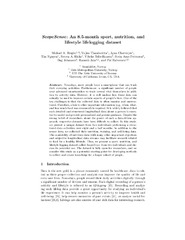Browsing Artikler, rapporter og annet (informatikk) by Author "Pettersen, Svein Arne"
-
Improved maximal strength is not associated with improvements in sprint time or jump height in high-level female football players: a clusterrendomized controlled trial
Pedersen, Sigurd; Heitmann, Kim Arne; Sagelv, Edvard Hamnvik; Johansen, Dag; Pettersen, Svein Arne (Journal article; Tidsskriftartikkel; Peer reviewed, 2019-09-17)<i>Background</i> - Maximal strength increments are reported to result in improvements in sprint speed and jump height in elite male football players. Although similar effects are expected in females, this is yet to be elucidated. The aim of this study was to examine the effect of maximal strength training on sprint speed and jump height in high-level female football players.<p> <p><i>Methods</i> ... -
Positional Differences in Peak- and Accumulated- Training Load Relative to Match Load in Elite Football
Baptista, Ivan; Johansen, Dag; Figueiredo, Pedro; Rebelo, Antonio; Pettersen, Svein Arne (Journal article; Tidsskriftartikkel; Peer reviewed, 2019-12-23)Quantification of training and match load is an important method to personalize the training stimulus’ prescription to players according to their match demands. The present study used time-motion analysis and triaxial-accelerometer to quantify and compare: a) The most demanding passages of play in training sessions and matches (5-min peaks); b) and the accumulated load of typical microcycles and ... -
Predicting peek readiness-to-train of soccer players using long short-term memory recurrent neural networks
Wiik, Theodor; Johansen, Håvard D.; Pettersen, Svein Arne; Matias Do Vale Baptista, Ivan Andre; Kupka, Tomas; Johansen, Dag; Riegler, Michael; Halvorsen, Pål (Conference object; Konferansebidrag, 2019-10-21)We are witnessing the emergence of a myriad of hardware and software systems that quantifies sport and physical activities. These are frequently touted as game changers and important for future sport developments. The vast amount of generated data is often visualized in graphs and dashboards, for use by coaches and other sports professionals to make decisions on training and match strategies. Modern ... -
Quantified Soccer Using Positional Data: A Case Study
Pettersen, Svein Arne; Johansen, Håvard D.; Baptista, Ivan; Halvorsen, Pål; Johansen, Dag (Journal article; Tidsskriftartikkel; Peer reviewed, 2018-07-06)Performance development in international soccer is undergoing a silent revolution fueled by the rapidly increasing availability of athlete quantification data and advanced analytics. Objective performance data from teams and individual players are increasingly being collected automatically during practices and more recently also in matches after FIFA's 2015 approval of wearables in electronic ... -
ScopeSense: An 8.5-Month Sport, Nutrition, and Lifestyle Lifelogging Dataset
Riegler, Michael Alexander; Thambawita, Vajira; Chatterjee, Ayan; Nguyen, Thu; Hicks, Steven; Telle-Hansen, Vibeke; Pettersen, Svein Arne; Johansen, Dag; Jain, Ramesh; Halvorsen, Pål (Chapter; Bokkapittel, 2023-03-29)Nowadays, most people have a smartphone that can track their everyday activities. Furthermore, a significant number of people wear advanced smartwatches to track several vital biomarkers in addition to activity data. However, it is still unclear how these data can actually be used to improve certain aspects of people’s lives. One of the key challenges is that the collected data is often massive and ... -
The variability of physical match demands in elite women's football
Matias Do Vale Baptista, Ivan Andre; Winther, Andreas Kjæreng; Johansen, Dag; Bredsgaard Randers Thomsen, Morten; Pedersen, Sigurd; Pettersen, Svein Arne (Journal article; Tidsskriftartikkel; Peer reviewed, 2022-01-21)Peak locomotor demands are considered as key metrics for conditioning drills prescription and training monitoring. However, research in female football has focused on absolute values when reporting match demands, leading to sparse information being provided regarding the degrees of variability of such metrics. Thus, the aims of this study were to investigate the sources of variability of match ...


 English
English norsk
norsk




